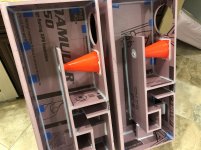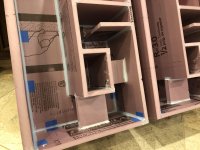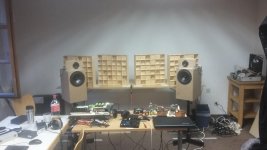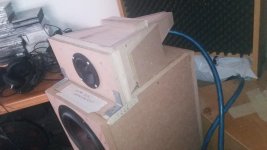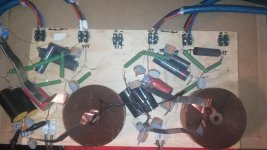You can’t beat a sub for the visceral energy it puts into a room. But for much music that is reasonable home listening SPL like 80dB to 85dB, I think this speaker might not need a sub. But some people may always like that extra punch a sub gives. On the sealed version of this speaker, a sub makes a big difference as it covers stuff below 50Hz.
I agree with Xrk. I found out that almost all sealed box speakers need (or benefit) a sub since their output is falling below 60 or 50 Hz. To some, that might sound fine, but not to me. On the other hand, ported ones, I mean the bigger ones or TL's (and MLTLs) easily reach 40 hz or lower...
Kef LS50 and 10F/8414 - Initial Comparison
I have yet to do a back-to-back listening session using the same position and stands, but my opinion so far is that the Kefs are such an entirely different configuration of speaker, as expected, so that it's not a particularly fair comparison. And in my 13x14 ft room I have the LS50s in an 8 ft equilateral triangle with my listening chair, 4 ft from the front wall. With the WAW midtweeters under the woofers, listening height at 8ft is critical for proper 1st-order crossover integration. For the Kef concentric 5" drivers with great dispersion this is not an issue, and I enjoy viewing the soundstage above and behind the tops of the very small LS50s on 25" stands. So, in my small room and somewhat close position the much smaller Kefs are a more appropriate speaker.
LS50 bass was a nice surprise. I had lowish expectations of a 5 incher in a ported box vs 8 inch sealed, but the tiny Kefs play tricks with physics. Bass actually loads the small room nicely, and is musical and tuneful. No one-note bass-reflex stuff here. Goes low enough for my taste.
I'll be setting the WAW monitors on my Skylan stands (made to suit the Kefs) for a listen. Right now running a newly-constructed Akitka power amp (highly recommended), which will also make for an interesting comparison.
Cam
I have yet to do a back-to-back listening session using the same position and stands, but my opinion so far is that the Kefs are such an entirely different configuration of speaker, as expected, so that it's not a particularly fair comparison. And in my 13x14 ft room I have the LS50s in an 8 ft equilateral triangle with my listening chair, 4 ft from the front wall. With the WAW midtweeters under the woofers, listening height at 8ft is critical for proper 1st-order crossover integration. For the Kef concentric 5" drivers with great dispersion this is not an issue, and I enjoy viewing the soundstage above and behind the tops of the very small LS50s on 25" stands. So, in my small room and somewhat close position the much smaller Kefs are a more appropriate speaker.
LS50 bass was a nice surprise. I had lowish expectations of a 5 incher in a ported box vs 8 inch sealed, but the tiny Kefs play tricks with physics. Bass actually loads the small room nicely, and is musical and tuneful. No one-note bass-reflex stuff here. Goes low enough for my taste.
I'll be setting the WAW monitors on my Skylan stands (made to suit the Kefs) for a listen. Right now running a newly-constructed Akitka power amp (highly recommended), which will also make for an interesting comparison.
Cam
Last edited:
There is a lot to be said for point source speakers with a coaxial woofer and tweeter. Like I said, I have heard the LS50’s and they were impressive sounding with bass beyond their little size. I know KEF spent a lot of R&D in the cabinet - it is reinforced and fitted with non resonant damping materials.
There are a surprising number of LS50 detractors out there, but I suspect most of them are using them in suboptimal conditions. My experience is that they are well-balanced, easy to drive, very easy to place, and are a lot like a largish desktop monitor that will work well on strands well away from walls. The Akitika amp with 50W 8Ohm/80W 4Ohm output has no trouble with them, and certainly shouldn't sweat the WAWs either. Sounds rather like a class A amp BTW, must be the current regulated PSU.
There are a surprising number of LS50 detractors out there, but I suspect most of them are using them in suboptimal conditions.
Hmm... I would say many have not ever owned them and many others never even listened to them. Internet and opinions etc.
Thanks! There might be a smaller (but larger than the sealed) standmount TL that might get a little bit lower than the current sealed. I will have to look at some of the different folding schemes some more. But since we were looking at floor standers I figure make it big and let it go low. If you listen to reasonable sound levels, there is no need for a subwoofer here.
X,
Very nice work as usual. Did you calculate the line using MJK's tools?
The acoustic foam (egg crate) is excellent in TLs (for that matter, I use it in all of my projects).
The tapered cone is sealed off so you are not pressuring the HF driver with the woofer?
Chees,
Greg
Hi Greg,
Thanks. No, I use Akabak - requires a 32bit PC though. Hard to come by nowadays so it runs inside a virtual machine with Win XP OS inside a 64bit Win 10 machine. Akabak is free for non commercial use and can be obtained from:
Akabak
I use Oracle VM software available here:
VM VirtualBox | Virtualization | Oracle
Akabak will require some learning curve but easy if you use a working script as template to get started. There is a thread on Akabak and a good starting point. A MLTL or double chamber reflex speaker are good places to start.
Member Don Hills, introduced me to Akabak years ago and I have used it since. He has lots of helpful tips here:
Akabak Simulator
Akabak is very flexible - it can simulate channels that loop, split, recombine, and even can add discrete passive electrical filters (XO) in the sim.
Thanks. No, I use Akabak - requires a 32bit PC though. Hard to come by nowadays so it runs inside a virtual machine with Win XP OS inside a 64bit Win 10 machine. Akabak is free for non commercial use and can be obtained from:
Akabak
I use Oracle VM software available here:
VM VirtualBox | Virtualization | Oracle
Akabak will require some learning curve but easy if you use a working script as template to get started. There is a thread on Akabak and a good starting point. A MLTL or double chamber reflex speaker are good places to start.
Member Don Hills, introduced me to Akabak years ago and I have used it since. He has lots of helpful tips here:
Akabak Simulator
Akabak is very flexible - it can simulate channels that loop, split, recombine, and even can add discrete passive electrical filters (XO) in the sim.
Progress Report
Spent the evening hacking up foam and glueing
The cones are a great idea X! The 10F/8424 driver has a perfectly sealed chamber, there is a hole drilled in the cone tip to pull the wire through and then it will be siliconed to seal.
X, for this test enclosure, do the drivers have to be flush mounted? Or, can I just drill holes in the plywood and mount them on top?
Spent the evening hacking up foam and glueing
The cones are a great idea X! The 10F/8424 driver has a perfectly sealed chamber, there is a hole drilled in the cone tip to pull the wire through and then it will be siliconed to seal.
X, for this test enclosure, do the drivers have to be flush mounted? Or, can I just drill holes in the plywood and mount them on top?
Attachments
Nice progress, Vunce! That sports cone looks like it was designed for that singular purpose as the fit is perfect. Did all your drivers and crossover parts arrive?
If you get a chance, I would break in the woofers while they are waiting to be installed. Play some nice deep bass house techno music through them while sitting in the open for a day or two. That will help loosen the suspension. You could wait until they are installed but they will be much louder once in a cabinet.
Great progress though!
If you get a chance, I would break in the woofers while they are waiting to be installed. Play some nice deep bass house techno music through them while sitting in the open for a day or two. That will help loosen the suspension. You could wait until they are installed but they will be much louder once in a cabinet.
Great progress though!

X, for this test enclosure, do the drivers have to be flush mounted? Or, can I just drill holes in the plywood and mount them on top?
Thanks X!
Yup, all parts arrived. The only obstacle now is time. My plan is to work on the front baffle today. Just had a question about mounting the drivers.
Thanks X!
Yup, all parts arrived. The only obstacle now is time. My plan is to work on the front baffle today. Just had a question about mounting the drivers.
woofers don't need to be flush mounted.
As for the mid-tweet, you could add a supra baffle if you want. Should be easy to do in XPS as well.
Example of supra-baffle:

If I may, that depends on the woofer, the intended operating BW, and the crossover design.
Surface mount woofers = obvious. Not an issue in & of itself with a quality example, used appropriately.
Non-surface-mount designs = more questionable and there can be significant variance depending on basket, surround design & cone profile. See for example Zaph|Audio
As far as the crossover goes, moving from flush to surface mounting changes the Z-axis relative position, and especially with lower order acoustical transfer functions can foul up the response there too if designed for one or the other, unless you redesign to account for this as appropriate / necessary.
Surface mount woofers = obvious. Not an issue in & of itself with a quality example, used appropriately.
Non-surface-mount designs = more questionable and there can be significant variance depending on basket, surround design & cone profile. See for example Zaph|Audio
As far as the crossover goes, moving from flush to surface mounting changes the Z-axis relative position
Hi Vunce,
For my prototypes, I mounted them non-flush on the 3/16in ply and it worked fine. I did try flush mounting by cutting a 3/16in thick sheet of foam core with the same hole diameters super imposed on the baffle and that flush mounted the drivers. There was an improvement in the mid and highs with smoothness but for purposes of the XPS pathfinder build, just top mounting is fine to check for bass extension and tightness of bass.
For my prototypes, I mounted them non-flush on the 3/16in ply and it worked fine. I did try flush mounting by cutting a 3/16in thick sheet of foam core with the same hole diameters super imposed on the baffle and that flush mounted the drivers. There was an improvement in the mid and highs with smoothness but for purposes of the XPS pathfinder build, just top mounting is fine to check for bass extension and tightness of bass.
FAST speaker finished
Dear loudspeaker fellows,
I have finished my FAST speakers a couple weeks ago. I have made things a bit different to what XRK has designed it, I would like to share this with you, perhaps it is interesting to you and the project.
The most important thing, that I made different to the original plans, is that have made a physical offset of the fullrange driver. It is 6,75cm, that's 2,66 inch. I have set up the speakers outdoors, and came to this distance by trying and listening, it was a decision by ear, 6,75cm is the distance, when it really sounds "on the spot", when the 3D of the sound picture is right and perfect (most foward part of the drivers to each other). To my ears this offset is very important, you miss quite a lot, when you do not mind.


As you can see in the picture, my dagger is rectangular, and the driver is positioned off center. I have made it of 1,9cm plywood, I regard it as important, to make the dagger massive. Because of the offset position I hope that I have less symmetry and therefor a smoother frequency response. The rectangular shape allows for a minimal distance to the woofer.
The final thing I made different, is, that I tried a couple of different capacitors and inductors. I have finally ended up with a 125€ inductor from Jantzen Audio, it is a band coil, which is hardened with a special wax. This coil really sounds "high-end", quite a difference to the usual air coil. The sound of the wax band coil is more stable, higher resolution, keener. To my ears it is worth the 100€ extra money, concerning the other money, you have to spend for the speakers.
The Dayton Audio Capacitors are really great capacitors, I very much like the neutral, musical sound. But there are capacitors, which have quite more resolution. In my setup I have got Jantzen Audio Alumen Z Caps for the small values, and a Jantzen Superior Z (3,9µF) as a bypass for the in sum 61µF big cap. I did not like the Alumen Z here. With the Superior Z Cap resolution is higher than with Dayton Audio only, but it does not sound that coherent any more, as compared to Dayton Audio only. My recommendation: If you want to enjoy music, go for the Daytons, if you need very good studio monitors, go for a Superior Z, perhaps it is worth to go for 61µF Superior Z - that I have not tried yet.
Thank you XRK, for sharing these are really awesome speakers with us! I have now got to know a transient perfect speaker, I now know about what it means, if a speaker has got a right step response, and I really do not want to go back to any other speaker any more, which is not transient perfect. I will keep looking for similar speakers, as I would like to spend more money on even better quality one day, what makes this speaker definitely not my last speakers, is, that the resolution of the treble is not the resolution of a real tweeter or ribbon tweeter. But after all, it is a really good speaker. I have also tried the Visaton B80 instead of the Scan Speak - but those drives (Visaton + Dayton) do not match, to my ears the Scanspeak matches perfectly with the Dayton. A very good combination, well done. - Thank you!
Florian
Dear loudspeaker fellows,
I have finished my FAST speakers a couple weeks ago. I have made things a bit different to what XRK has designed it, I would like to share this with you, perhaps it is interesting to you and the project.
The most important thing, that I made different to the original plans, is that have made a physical offset of the fullrange driver. It is 6,75cm, that's 2,66 inch. I have set up the speakers outdoors, and came to this distance by trying and listening, it was a decision by ear, 6,75cm is the distance, when it really sounds "on the spot", when the 3D of the sound picture is right and perfect (most foward part of the drivers to each other). To my ears this offset is very important, you miss quite a lot, when you do not mind.
As you can see in the picture, my dagger is rectangular, and the driver is positioned off center. I have made it of 1,9cm plywood, I regard it as important, to make the dagger massive. Because of the offset position I hope that I have less symmetry and therefor a smoother frequency response. The rectangular shape allows for a minimal distance to the woofer.
The final thing I made different, is, that I tried a couple of different capacitors and inductors. I have finally ended up with a 125€ inductor from Jantzen Audio, it is a band coil, which is hardened with a special wax. This coil really sounds "high-end", quite a difference to the usual air coil. The sound of the wax band coil is more stable, higher resolution, keener. To my ears it is worth the 100€ extra money, concerning the other money, you have to spend for the speakers.
The Dayton Audio Capacitors are really great capacitors, I very much like the neutral, musical sound. But there are capacitors, which have quite more resolution. In my setup I have got Jantzen Audio Alumen Z Caps for the small values, and a Jantzen Superior Z (3,9µF) as a bypass for the in sum 61µF big cap. I did not like the Alumen Z here. With the Superior Z Cap resolution is higher than with Dayton Audio only, but it does not sound that coherent any more, as compared to Dayton Audio only. My recommendation: If you want to enjoy music, go for the Daytons, if you need very good studio monitors, go for a Superior Z, perhaps it is worth to go for 61µF Superior Z - that I have not tried yet.
Thank you XRK, for sharing these are really awesome speakers with us! I have now got to know a transient perfect speaker, I now know about what it means, if a speaker has got a right step response, and I really do not want to go back to any other speaker any more, which is not transient perfect. I will keep looking for similar speakers, as I would like to spend more money on even better quality one day, what makes this speaker definitely not my last speakers, is, that the resolution of the treble is not the resolution of a real tweeter or ribbon tweeter. But after all, it is a really good speaker. I have also tried the Visaton B80 instead of the Scan Speak - but those drives (Visaton + Dayton) do not match, to my ears the Scanspeak matches perfectly with the Dayton. A very good combination, well done. - Thank you!
Florian
Attachments
Hi Florian,
I love what you did! Outstanding!!! To put the due diligence to test the tweeter setback by ear, outdoors with a ruler. Nice.
Also not surprised that a premium flat copper ribbon inductor sounds better. One thing we could try is a thicker gauge wire air core. Thank you for trying the speaker with all your heart and means. It’s reassuring to know basic budget MKP caps from Dayton work well. I might try bypassing the 61uF with 0.022uF copper in oil like Maty recommends or at least try a metallized polycarbonate film one that Vunce provided me. Those sound as goo, if not better than more expensive Mundorf EVO aluminum in oil caps.
Thank you for the effort and for the kind words. I sometimes get a bit evangelical about how important a good step response is - but now you know, it is all worth it!
Happy new year!
X
I love what you did! Outstanding!!! To put the due diligence to test the tweeter setback by ear, outdoors with a ruler. Nice.
Also not surprised that a premium flat copper ribbon inductor sounds better. One thing we could try is a thicker gauge wire air core. Thank you for trying the speaker with all your heart and means. It’s reassuring to know basic budget MKP caps from Dayton work well. I might try bypassing the 61uF with 0.022uF copper in oil like Maty recommends or at least try a metallized polycarbonate film one that Vunce provided me. Those sound as goo, if not better than more expensive Mundorf EVO aluminum in oil caps.
Thank you for the effort and for the kind words. I sometimes get a bit evangelical about how important a good step response is - but now you know, it is all worth it!
Happy new year!
X
Last edited:
- Home
- Loudspeakers
- Full Range
- 10F/8424 & RS225-8 FAST / WAW Ref Monitor
